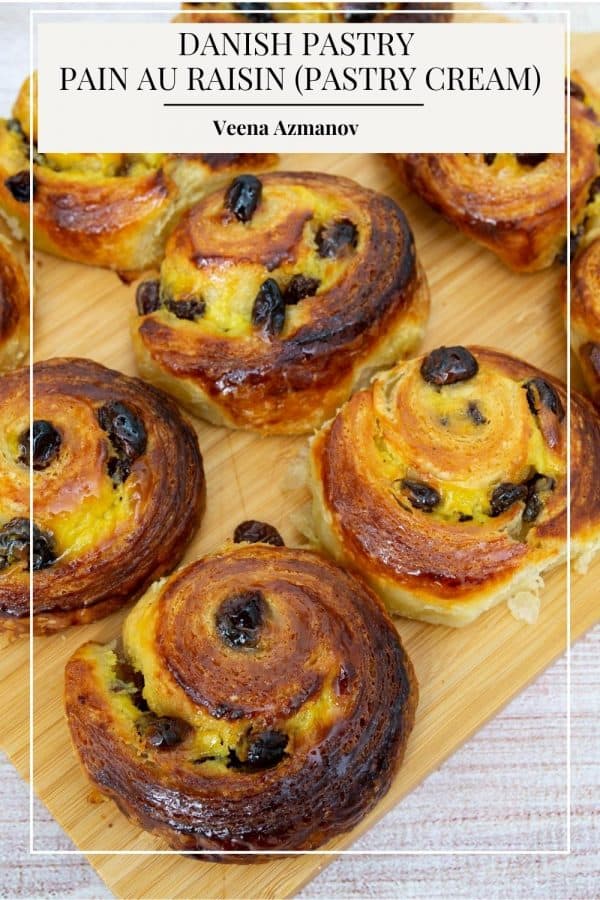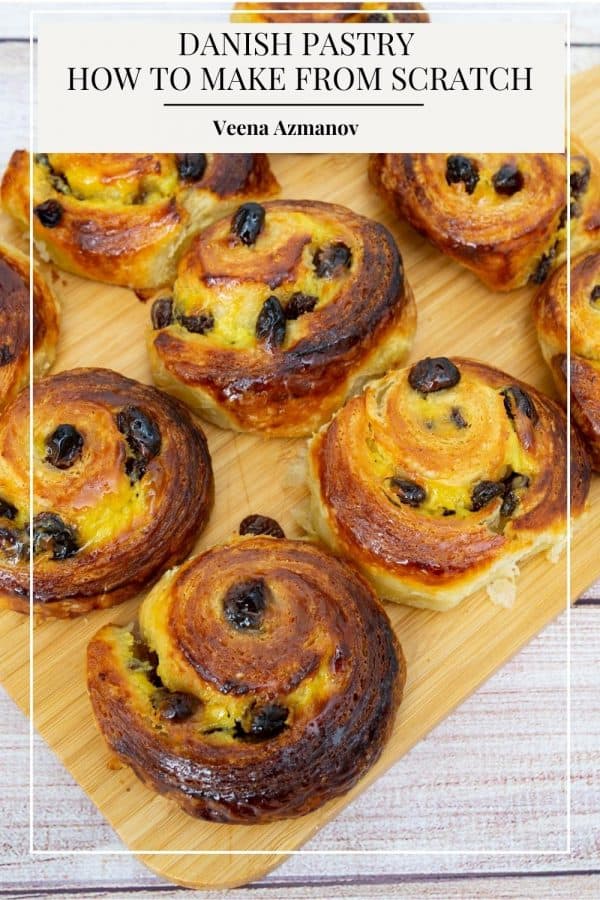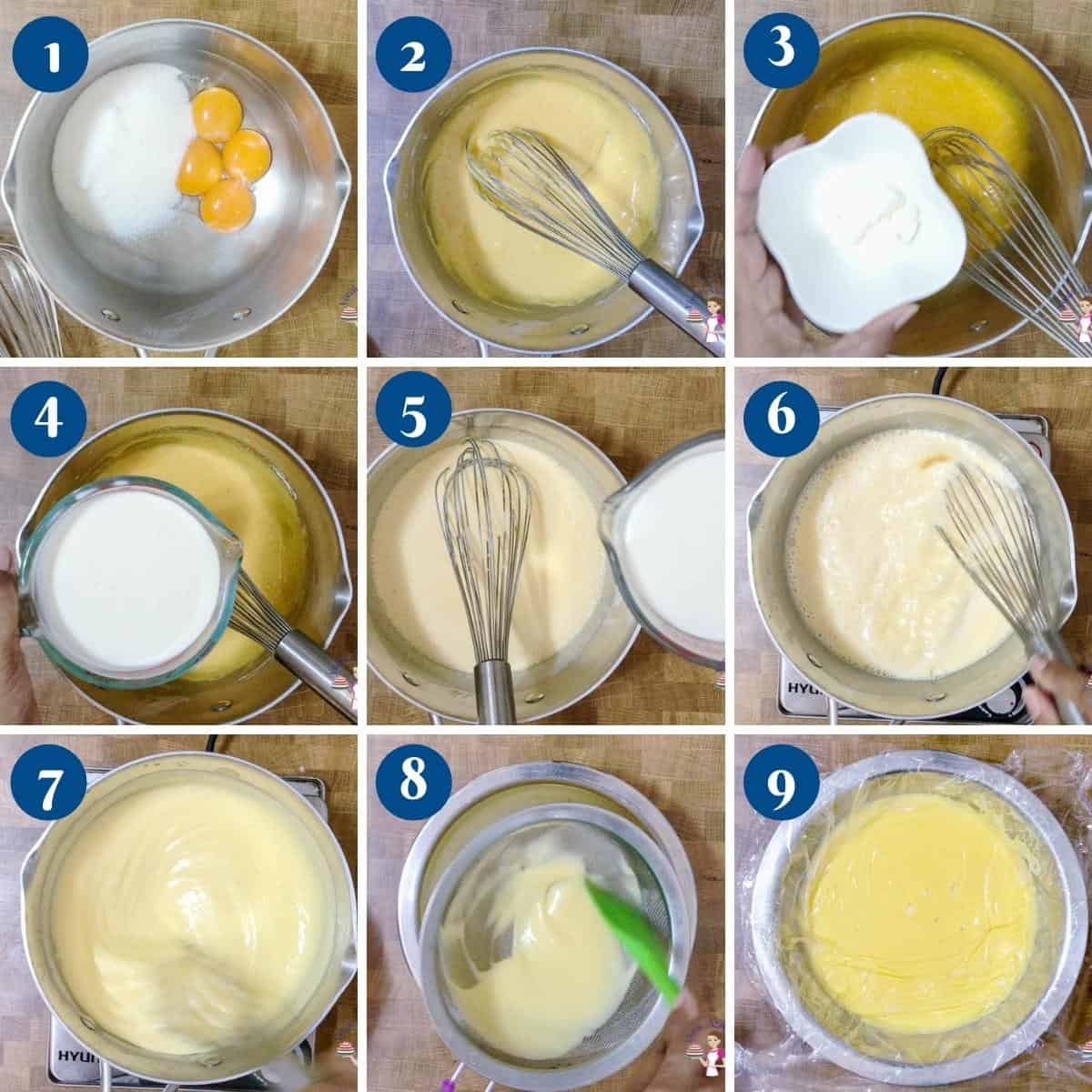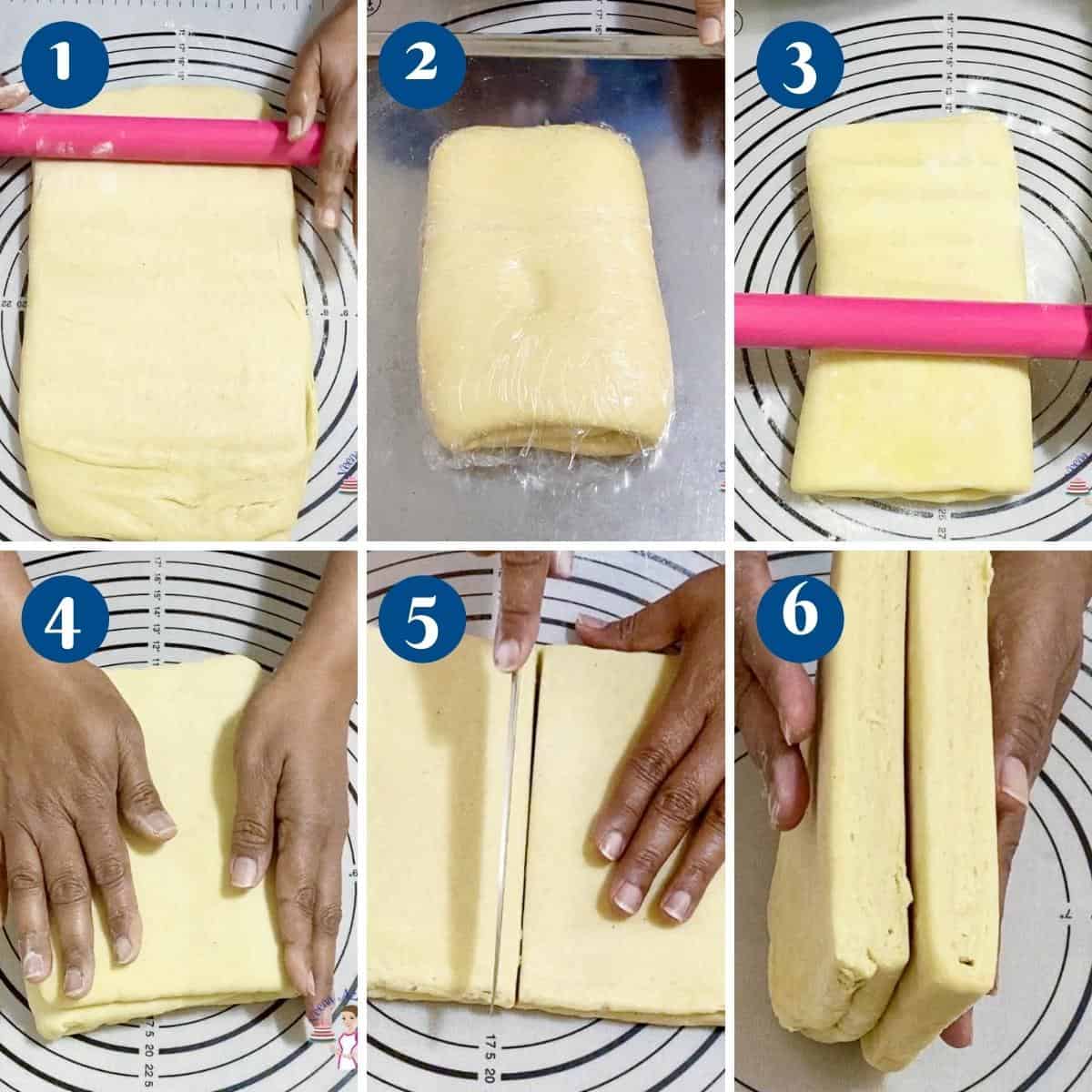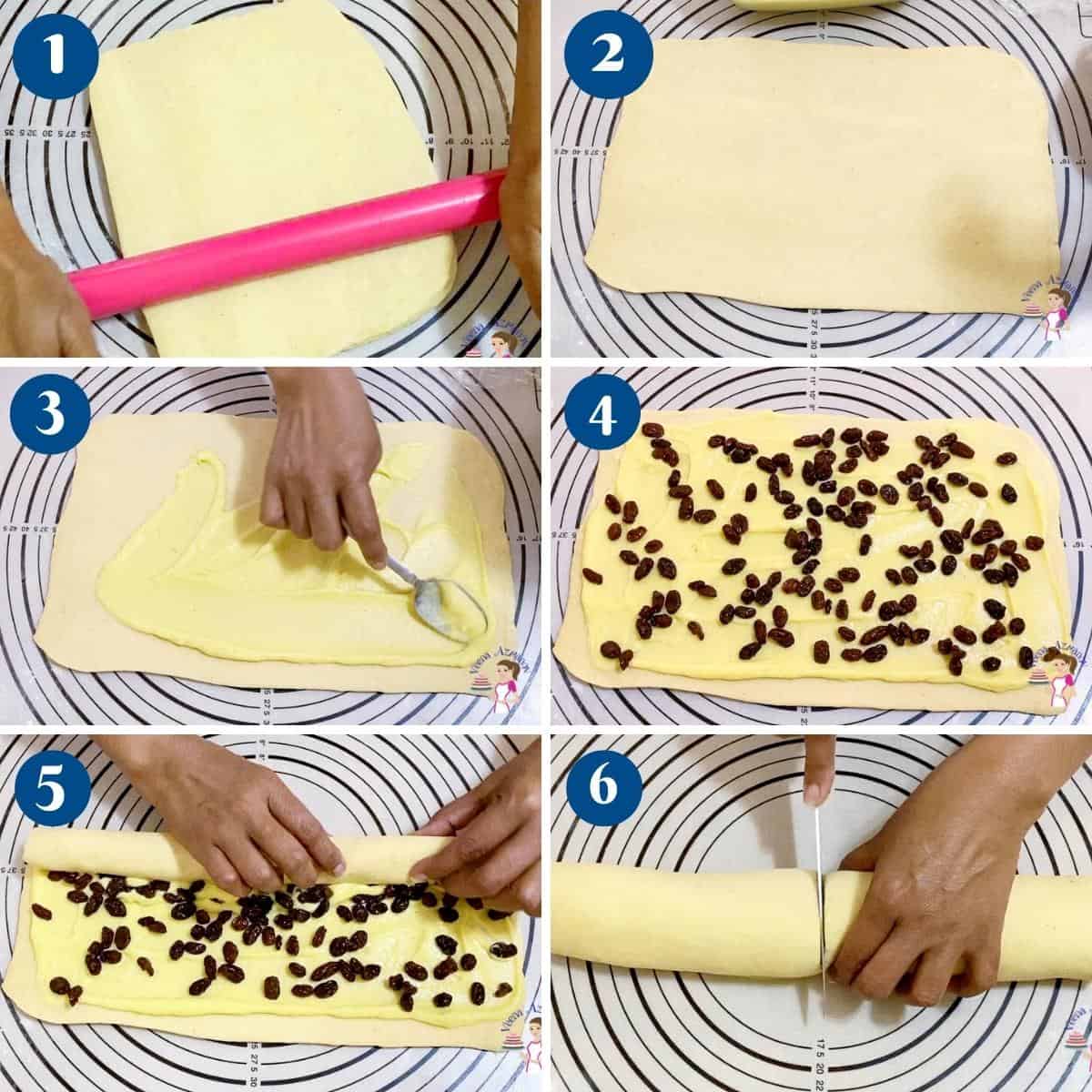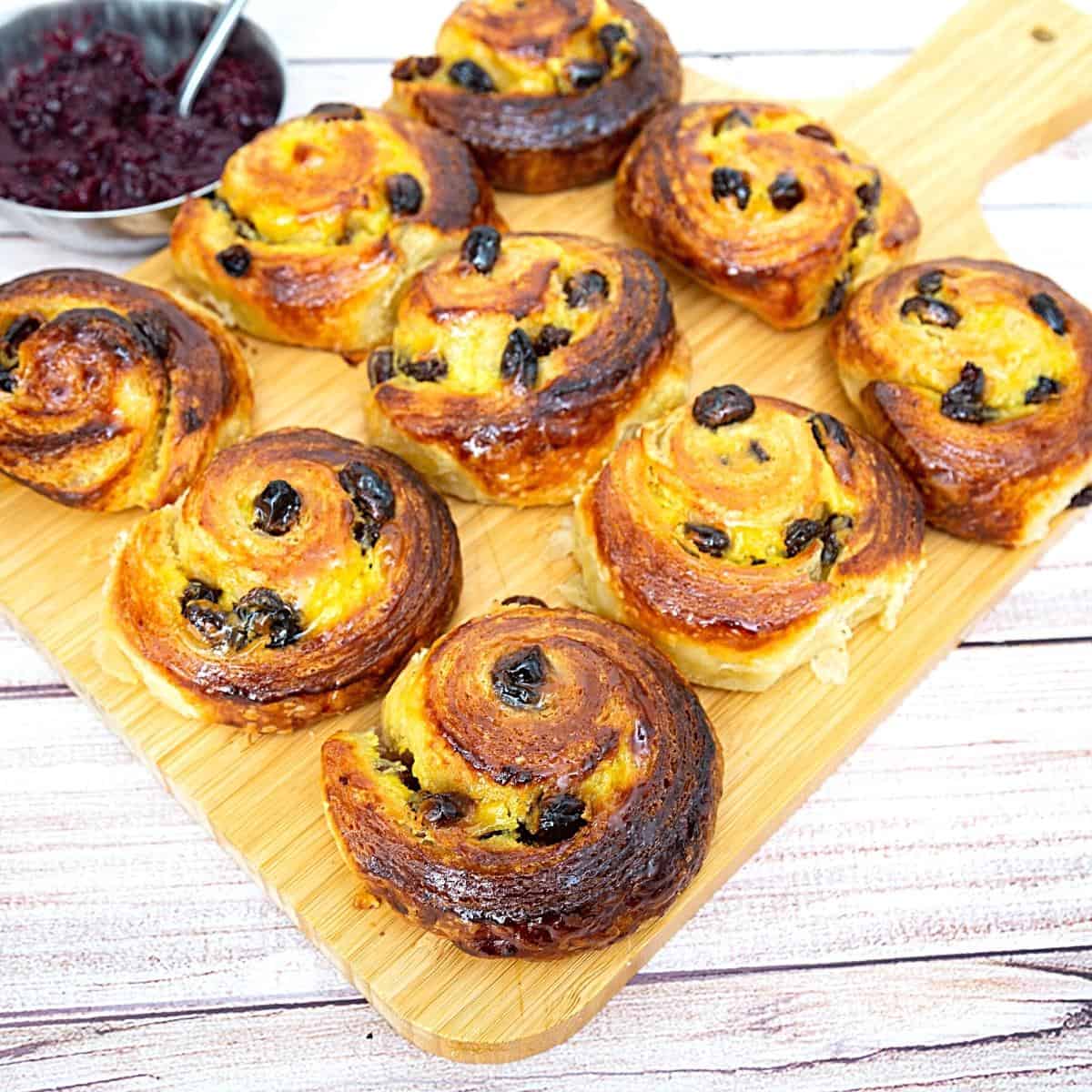Danish pastries, or Viennese (wienerbrød) in Denmark, is made with a laminate dough similar to puff pastry and croissants. And, Danish pastry dough includes yeast, eggs, sugar, and butter. Then, it’s laminated with more butter, which results in tender but rich flaky, buttery pastries with lots of layers. You can use the Danish pastry dough to create many different shapes or varieties of Viennese (pastries), such as these pastry cream raisins spirals, cinnamon sugar spirals, and danish pinwheels or darts, cylinders, stars, braids, envelopes, pockets, combs, squares, horns, etc. The filling in these shapes can be different as well. You can pick any shape and choose a filling. For example, try cream cheese, almond cream, pastry cream, jams, and fruit fillings as well as fresh fruits. In fact, the options are endless. Danish pastry has always been my weakness. And soon, I plan to share many of these shapes and filling using the danish dough.
Why make this Danish pastry
As I said above, we are using the danish pastry dough as our base and pastry cream as our choice for filling. And yet, you can also use cream cheese, as we did in our Danish strawberry braid, and Danish pastry pinwheels or almond cream, as we did in our blackberry braid. In addition, this is a very forgiving dough that’s easy to knead with a stand mixer or by hand. There are four main components to this danish pastry spirals:The dough – this is a simple yeast-based dough with eggs, butter, and sugar. It can be soft and sticky to work with, so don’t skip the chilling times.Butter block – yes, it is lots of butter, which we cream with a little flour and then laminate between the dough. The purpose of the flour in the butter is to help stabilize it. Most professionals often skip the flour, but I recommend you use it.Pastry cream – made with milk, cream, sugar, and egg yolks, then, cooked until thickened. You need to chill it for at least 4 hours before you use it. Raisins – I am soaking these in rum for 4 hours. But, you can just soak these in warm water for an hour. The purpose of soaking the raisins is so they are moist and tender before we add them to the pastry. As a result, they do not take moisture out of the pastry.
This is a classic danish dough and you could use the same dough to make other shapes and filings too such as the Danish cream cheese cylinders, Danish pinwheels, Danish braided pastry, etc.
Danish pastry – Pain au raisin
Pastry cream
In a heavy bottom saucepan, add the egg yolks, sugar, flour, and vanilla bean paste. Combine until smooth. Then, add the salt and vanilla extract. Followed by the milk. Stirring constantly to avoid lumps.Pro tip – Gradually, add the milk a little at a time to prevent lumps.Then, place the pan on medium-low heat and continue to cook the pastry cream stirring all the time. When the pastry cream is thick and coats the back of a wooden spoon or spatula add the butter and take it off the heat.Pro tip – The liquid will transform from a foamy liquid to a thick custard with no foam at all. The cream must be thick so it can be spread in the pastry.Strain through a mesh or sieve – discard the vanilla pod as well as any curdled eggs. Cover the surface of the pastry cream with plastic wrap. Chill in the fridge for 4 to 6 hours.Pro tip – straining will ensure a smooth texture and remove any curdled or thickened milk solids. The cream must be thick so it can be spread in the pastry.
Raisins
Soak the raisins in rum for 4 hours up to overnight. Drain well before using it.
Apricot glaze
Heat the apricot jam and water on low heat until dissolved. Strain through a sieve – set aside until ready to use.Pro tip – If necessary, warm in the microwave for 10 seconds before using it.
Danish dough
Dry ingredients – In the bowl of a stand mixer with the hook attachment combine flour and salt. Set aside. You can also use a food processor to make this dough.Pro tip – Salt slows fermentation so we add it to the flour rather than directly into the wet mixture.Yeast mixture – In a measuring cup or bowl, combine milk, sugar, yeast, egg, and vanilla extract.Pro tip – you don’t need to activate the instant variety but, I like to ensure my yeast is good. So, I leave the mixture aside for 3 to 5 minutes, if it foams it’s good to go.Wet to dry – Then, add the yeast mixture to the flour mixture. Combine on medium-high until all flour is incorporated. Knead a minute more.Pro tip – the dough will be soft and sticky but do not add any more flour just yet.Knead – Then, gradually add the room temperature butter, one tablespoon at a time. Then, knead for 3 minutes on medium Alternatively, you can knead by hand for 5 to 7 minutes.Rest – The dough will be soft and slightly sticky. Remove from the mixer, and shape into a ball. Place in an oiled bowl, cover with plastic wrap and chill for 15 minutes.Pro tip – Unless the dough is too soft and sticky you do not need to add any more flour. Also, if necessary add a few tablespoons only.
Butter blocks
Template – Use a parchment paper to create a template 12 x 6-inches (see video) – set aside.Cream – In the same bowl of the electric mixer bowl (no need to wash), cream the butter and flour just until combined. Transfer to the prepared parchment paper template. Spread evenly with a spatula. Use a rolling pin to guide it inside of the template towards the corners (see video)Divide – Use a ruler to mark them at 6 inches. So, now this will give you two 6 x 6-inch blocks (see video).Pro tip – we need 2 sheets of butter 6 x 6 inches each. You can use a 6-inches square baking pan to make two such blocks. This 12 x 6 method ensures the blocks are even.Pro tip – be gentle with the rolling pin using a spreading motion so the butter doesn’t come out of the corners.Chill in the fridge for 15 minutes.Pro tip – We want the fat to be cold but still be flexible so that when we roll it will spread between the folds. If you chill too long it will break rather than spread.
Laminate the dough
Roll – Transfer the dough to a lightly floured surface. Roll to a long rectangle of 7 x 18-inches.Fold – Open the butter block and divide it into 2 at the mark you created. Now you should have two – 6 x 6-inch blocks. Place one block over the center. Fold one side over. Then, place the second block on top and fold the other side over.Pro tip – Now you should have layers of dough, butter, dough, butter, dough – makes sense?Chill – Wrap the dough, place it on a baking sheet, and into the refrigerator – chill for 15 minutes.Pro tip – if the dough and butter are still cold when you wrap you can continue with the first fold. Also, in warm places, you may need more cooling time.
Folds / turn
Turn the dough – Roll the chilled pastry dough into a rectangle – with the short side facing you. Roll to a rectangle approximately 6 x 12-inches.First fold – Fold the dough lengthways into thirds like a business letter (see video). Wrap in plastic on a baking sheet and place into the fridge to chill for 30 minutes.Second fold – Roll the dough lengthways again with the short side facing you – (see video) to about 6 x 12-inch long again. Fold the dough into thirds again like a business letter (see video). Place in the fridge for 30 minutes if necessary.Third fold – Roll the dough lengthways again with the short side facing you – (see video) to about 6 x 12-inch long again. Fold the dough into thirds again like a business letter (see video).Chill – After the third fold, chill in the fridge for at least two hours or until well chilled. This can be chilled for up to 48 hours.Pro tip– it is very important that the dough be well cold before using; otherwise, the folds will blend ruining all your effort.Divide – Roll the dough into a 6 x 12-inches rectangle. Divide into 2. Place one in the fridge while you work on the second one.Pro tip – you want to work in batches so the dough stays cold at all times. Also, it means you won’t roll too thick.
Shape the dough
Rectangle – Roll the dough to about a 10 x 12-inch rectangle.Pro tip – it is very important that the dough is very chilled when you roll otherwise the butter can ooze out of the sides and you will not have a flaky pastry.Fill – Spread a generous amount of pastry cream over the dough making sure to get all the corners as well. Sprinkle the soaked and drained raisins. Roll the dough (like a jelly roll).Pro tip – this process is similar to making cinnamon rolls. If necessary chill the dough in the fridge again before slicing.Divide – Cut into 1 1/2-inch slices, (about 12). Cut half, then each half into half until you have 12 pieces. Place on a silicone mat or parchment-lined baking trayProof – Place on a baking tray and cover the pinwheels with a clean kitchen cloth – let poof for 45 minutes.
Bake the danish
Oven – Preheat the oven at 375°F/ 190°C / Gas Mark 5. Brush the pastry with a beaten egg.Bake – Bake in the hot oven for 20to 25 minutes until rich golden brown.Pro tip – if the pastries become too dark while baking, tent them with an aluminum foil.Glaze- Remove from the oven and let cool on the tray for 10 minutes. Then, using a pastry brush glaze them with the prepared apricot glaze. (below)Pro tip – if you brush while the pastry is very hot it will absorb all the glaze and become too sweet and you won’t have that shiny appearance.Cool – Transfer to a cooling rack and cool them completely before storing. These pastries are best enjoyed on the day they are baked. But, they also freeze well for months.
Frequently asked questions
Thank you for sharing - Save for later

